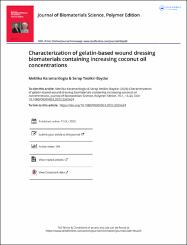Characterization of gelatin-based wound dressing biomaterials containing increasing coconut oil concentrations
Özet
This study determined the influence and ideal ratios of various
coconut oil (CO) amounts in gelatin (G) based-films as wound
dressings since there are limited comparative studies to evaluate
the sole effect of increasing CO on protein-based biomaterials.
Homogenous films at G:CO ratio of 4:0,4:2,4:3,4:4 (w:w) corresponding to CO-0, CO-2, CO-3, CO-4, respectively, were obtained using
solution casting. SEM showed CO caused rougher surfaces decreasing mechanical strength. However, no pores were observed in
CO-4 due to bigger clusters of oil improving stretchability compared to CO-3; and durability since aging of CO-4 was >10% lower
than CO-0 in aqueous media. FTIR showed triglycerides’ band only
in CO films with increasing amplitude. Moreover, amide-I of CO-2
was involved in more hydrogen bonding, therefore, CO-2 had the
highest melt-like transition temperatures (Tmax) at ~163°C while
others’ were at ~133°C; and had more ideal mechanical properties
among CO films. XTT showed that increased CO improved 3T3 cell
viability as CO-0 significantly decreased viability at 10,50,75,100μg/
mL (p<0.05), whereas CO-2 and CO-3 within 5-75μg/mL and CO-4
within 5-100μg/mL range increased viability ≥100% suggesting
proliferation. All CO samples at 25μg/mL stimulated 3T3 cell migration in Scratch Assay indicating wound healing. CO amounts mainly
improved thermal and healing properties of gelatin-based biomaterial. CO-2 was more thermally stable and CO-4 had better influence on cell viability and wound healing than CO-0. Therefore,
increased CO ratios, specifically 4:2 and 4:4, G:CO (w:w), in
gelatin-based films can be ideal candidates for wound dressing
materials.

















